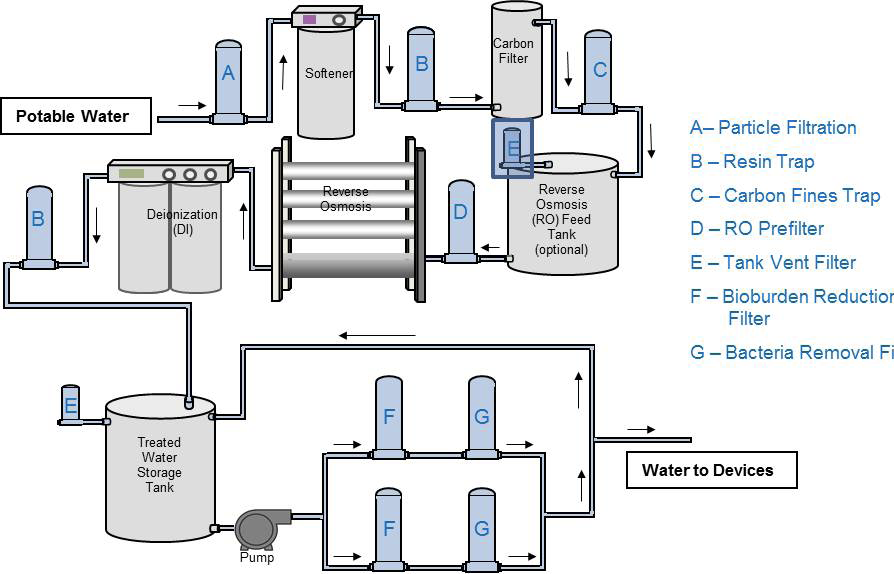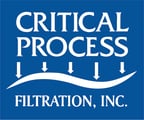People in healthcare facilities are vulnerable to infection, and bacteria that have little to no effect on healthy people can cause serious harm to anyone with a weakened immune system.
Most people don’t realize that tap water is not sterile. There are bacteria present even if the water has been chlorinated. In the vast majority of cases, the bacteria have no ill effect on anyone using tap water. However, when that water enters a medical facility, the bacteria are a big concern.
There are many possible configurations of water systems in medical facilities. This summary focuses on two that represent the range of possibilities – a filter system for rinse water used in semi-critical device cleaning and high-level disinfection (Figure 1) and a dialysis water system (Figure 2).

Figure 1 - Tap Water Filtration for Medical Device Reprocessing

Figure 2 - Filters in a Central Water System for a Healthcare Facility
Understanding Bacteria Filters
In medical applications, the filter system is expected to remove all bacteria so that the resulting water is ‘bacteria-free’. The best filters for bacteria removal are ‘sterilizing filters’ made to pharmaceutical industry standards. They must be tested and proven to remove ‘all’ bacteria. Documentation of performance is usually provided in the form of a certificate of compliance in each filter package. That certificate needs to state that the filter has passed quality tests proving that it will remove bacteria. Critical Process Filtration supplies pharmaceutical-grade filters to medical facilities with the appropriate documentation.
Removing Bacteria from Tap Water
In most facilities that reprocess semi-critical devices, like endoscopes, the water used for washing and rinsing is normal tap water. The number of particles and bacteria will vary widely based on the source of the water and the age of the municipal water distribution piping. Filter systems need to remove particles as small as 0.22 microns to assure that the water is bacteria-free. The final filter in the system is the one that removes the bacteria and needs to be protected from larger particles or it will become plugged very quickly. The 3-stage system shown in Figure 1 is used for water with high particle loads so that the bulk of particles are removed by the first 2 filters to protect that final filter. If the tap water is cleaner, then one particle filter will usually be enough to protect the final bacteria filter.
Insurance Against Water System Contamination
Figure 2 shows a common configuration for a dialysis water system. Similar systems may be found treating water for laboratories or sterile processing departments in surgical centers and hospitals. The most common practice is to purify the water with a reverse osmosis (RO) unit followed by a deionization (DI) system and store it in a tank before distribution through a re-circulating loop to points of use in the facility.
As the water is stored and distributed it has no chemical protection against bacteria. Chlorine has been removed as part of the purification process, so any organisms that enter the system will be viable and could be distributed to all parts of the system and could even form biofilms. Systems are usually subjected to periodic chemical or heat sanitization processes, but bacteria can still enter between these cycles through open tank vents, open distribution lines, or ‘dead legs’.
Housings F and G are where ‘bioburden reduction’ and ‘bacteria removal’ filters are located in the distribution loop. The bioburden reduction filter reduces the number of bacteria in the system and lowers the probability of biofilm formation. The bacteria removal filter has a smaller pore size and is designed to completely remove bacteria from the water stream. Because the distribution loop may be constantly re-circulating, many systems install 2 sets of filters to allow filter replacement without having to shut off the flow. Figure 4 shows that arrangement.
Tank vent filters (Housing E in Figure 2) are also critical to the bacteria removal process.
Filter Options
All of the filters chosen need to tolerate chemical disinfectants used in the system (bleach, peracetic acid, etc) and any heat sterilization or sanitization cycles (hot water or steam). The table below shows the filter media options from Critical Process Filtration. All are available in cartridges and capsules for large and small systems.
